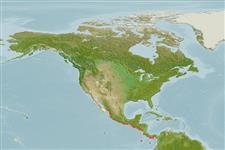Environment: milieu / climate zone / depth range / distribution range
Ökologie
seewasser; brackwasser. Tropical; 25°N - 4°N
Eastern Pacific: Gulf of California to northern Colombia.
Size / Gewicht / Alter
Maturity: Lm ? range ? - ? cm
Max length : 37.4 cm SL Männchen/unbestimmt; (Ref. 95327); common length : 25.0 cm TL Männchen/unbestimmt; (Ref. 55763); max. veröff. Gewicht: 626.00 g (Ref. 124487)
Body elongate and somewhat compressed; dorsal profile slightly concave above the eyes; lateral line extending to posterior edge of caudal fin; second anal spine, when folded down, reaching or surpassing origin of caudal fin; pectoral and pelvic fins sub-equal; first gill arch with 26 to 31 gill rakers; back blue gray; belly white; lateral line pale; membranes between dorsal spines and between second and third anal spines pale (Ref. 55763).
Adults are found mainly in estuaries but also enter freshwater to an elevation of 50 m. Diet consists primarily of fish, crustaceans and mollusks (Ref. 36880).
Life cycle and mating behavior
Geschlechtsreife | Fortpflanzung | Ablaichen | Eier | Fecundity | Larven
Bussing, W.A., 1995. Centropomidae. Róbalos. p. 987-995. In W. Fischer, F. Krupp, W. Schneider, C. Sommer, K.E. Carpenter and V. Niem (eds.) Guia FAO para Identification de Especies para lo Fines de la Pesca. Pacifico Centro-Oriental. 3 Vols. FAO, Rome. (Ref. 9284)
IUCN Rote Liste Status (Ref. 130435)
Bedrohung für Menschen
Harmless
Nutzung durch Menschen
Fischereien: kommerziell; Sportfisch: ja
Mehr Information
NamenSynonymeMetabolismusRäuberÖkotoxikologieFortpflanzungGeschlechtsreifeAblaichenSpawning aggregationFecundityEierEientwicklung
ReferenzenAquakulturAquakultur ProfilZuchtlinienGenetikElectrophoresesVererbbarkeitKrankheitenVerarbeitungNutrientsMass conversion
PartnerBilderStamps, Coins Misc.LauteCiguateraGeschwindigkeitSchwimmstilKiemenoberflächeOtolithsGehirngrößeSehfähigkeit
Tools
Zusatzinformationen
Download XML
Internet Quellen
Estimates based on models
Preferred temperature (Ref.
123201): 24 - 28.6, mean 27.5 °C (based on 26 cells).
Phylogenetic diversity index (Ref.
82804): PD
50 = 0.5005 [Uniqueness, from 0.5 = low to 2.0 = high].
Bayesian length-weight: a=0.00759 (0.00508 - 0.01134), b=3.03 (2.91 - 3.15), in cm total length, based on LWR estimates for this species & Genus-body shape (Ref.
93245).
Trophic level (Ref.
69278): 3.8 ±0.59 se; based on food items.
Widerstandsfähigkeit (Ref.
120179): hoch, Verdopplung der Population dauert weniger als 15 Monate. (Preliminary K or Fecundity.).
Fishing Vulnerability (Ref.
59153): Moderate vulnerability (36 of 100).
Nutrients (Ref.
124155): Calcium = 187 [113, 334] mg/100g; Iron = 1.62 [0.97, 2.52] mg/100g; Protein = 19.6 [17.2, 21.9] %; Omega3 = 0.299 [0.130, 0.710] g/100g; Selenium = 37.4 [18.2, 81.0] μg/100g; VitaminA = 14.5 [5.7, 39.0] μg/100g; Zinc = 1.5 [1.1, 2.1] mg/100g (wet weight);
